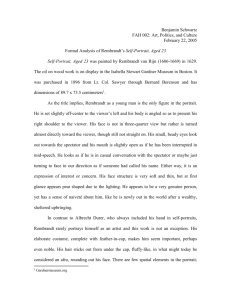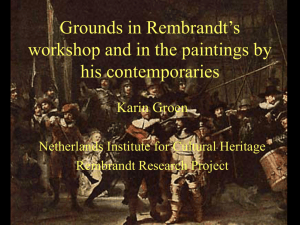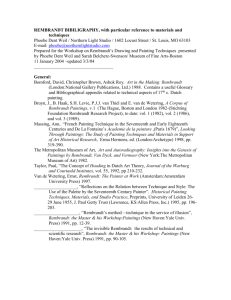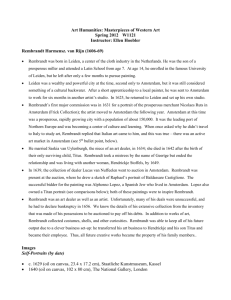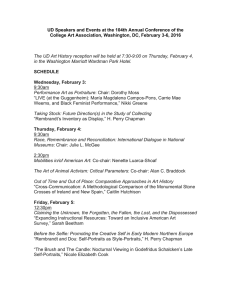revie iews Reviews Karen Lang
advertisement
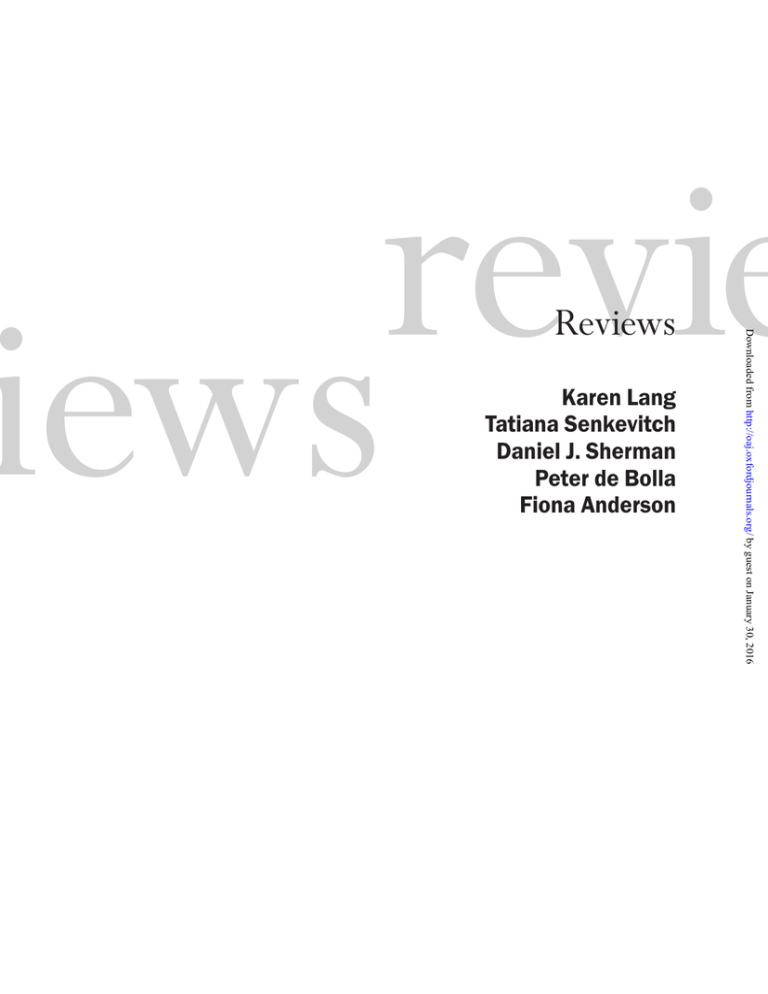
Reviews Karen Lang Tatiana Senkevitch Daniel J. Sherman Peter de Bolla Fiona Anderson Downloaded from http://oaj.oxfordjournals.org/ by guest on January 30, 2016 iews revie Downloaded from http://oaj.oxfordjournals.org/ by guest on January 30, 2016 Book Reviews Modernism and Rembrandt Karen Lang Jonathan Bikker and others, Rembrandt, the Late Works (London and Rijksmuseum, Amsterdam: New Haven and London: National Gallery, 2014), 253 colour and 10 b&w illns, 304pp., ISBN 978-1-85709-557-9, hardcover £19.95. Richard Verdi, Rembrandt’s Themes: Life into Art (New Haven and London: Yale University Press, 2014), 60 colour and 170 b&w illns, 308pp., ISBN: 978-0300201536, hardcover £45. # The Author 2015. Published by Oxford University Press; all rights reserved OXFORD ART JOURNAL 38.3 2015 427 –451 Downloaded from http://oaj.oxfordjournals.org/ by guest on January 30, 2016 Art history situates the artwork within categories of time, place, and style. In special cases, works of art exceed these categories. The masterpiece is the work which surpasses categorisation. The work of art of universal significance is another. Rembrandt has been positioned and repositioned in the history of art. Today, Rembrandt resides in the firmament alongside those other (mostly Renaissance, mostly male) artists we know by their first names. The Rembrandt Research Project has ended its long, rather contentious labour of authenticating the paintings and Ernst van de Wetering’s monumental survey, Rembrandt’s Paintings Revisited (Springer, Dordrecht, 2014), has presented substantial reattributions and perhaps more importantly for art history, it has helped to shift the focus from connoisseurship to ‘processes’ of artistic creation, the evidence of contemporary texts and the analysis of painting technique.1 The exhibition in 2014 of Rembrandt’s late works organised by the National Gallery, London, and the Rijksmuseum, Amsterdam, of approximately ninety paintings, prints, and drawings from the early 1650s to the artist’s death in 1669 (more were included in the second venue in Amsterdam), and the publication in the same year of Richard Verdi’s monograph, Rembrandt’s Themes: Life into Art, present an artist of the first rank. They focus on the artist’s themes, including elemental themes of life and death, to argue for the universal significance of Rembrandt’s art. As much as our inner critic may want to crush the claim for universality beneath the boot of intellectual criticism or theory, Rembrandt’s art would no doubt have the last view. The status and appeal of Rembrandt’s art courts the danger for the art historian of falling into the trap of the myth of artistic genius and its corollary, the universality of art. At their best, these publications concentrate on what we see in the artwork (in the exhibition catalogue, the scientific techniques of x-radiography, and infra-red imaging expand our view), they show how seeing turns into meaning and they make a claim for universal significance based on these findings. In this way the authors stake a claim for the appeal of Rembrandt’s art across time, and, extending their claim to the present context of this review, across art-historical specialism. Precisely on account of this claim an art historian with a research focus in modern art may be permitted to comment on these publications, not as a specialist of course but as an interested beholder and reader. The research vantage of the twentieth century raises the questions of appeal across time and universal significance and it adds to these the relation of Rembrandt to the artistic tradition of what follows, namely, to modern art. How modern artists have responded to Rembrandt’s art is therefore raised as a legitimate question. This may come as a surprise to modernists, since the theory of the avant-garde, which underpins modern art history, puts the artist ahead of his or her time. Simply put, modern art history’s reliance upon the theory of the avant-garde has thwarted the study of the artist’s engagement with the art of the past. After two centuries of neglect, Rembrandt was rediscovered in France in the mid-nineteenth century. His biography was shaped to fit the myth of the modern artist, misunderstood, and penniless, and his style was viewed as a forerunner to the latest impulses in art. Significantly, the artist’s etchings were included in this revival. The impressive technical innovations of Rembrandt’s prints facilitated the acceptance of etching as an art form in its own right.2 The Rembrandt revival reached Germany soon afterward. Wilhelm von Bode acquired major paintings and graphic work for the Berlin museums and he also played a key role in Rembrandt connoisseurship.3 Rembrandt became a household name when Julius Langbehn declared him the artist of the Volk in his runaway bestseller of 1890, Rembrandt als Erzieher (Rembrandt as Educator). Yet Rembrandt also appealed to the modern artists Langbehn despised, namely, to Max Liebermann, Max Slevogt, and Lovis Corinth, the founding members of the Berlin Secession. Where Langbehn had fit Rembrandt into the Procrustean bed of a reactionary nationalism, Liebermann, Slevogt, and Corinth considered Rembrandt’s art vital, and contemporary. They admired Rembrandt’s individual solutions to artistic problems – problems such as how to set the figure in space, how to invoke emotion and create mood and how to achieve a sense of time passing in a static composition – and they understood their modern art in living relation to his. For these modern German artists, artistic tradition is neither static nor fixed; it is relative and variable – the artist’s relation to the art of the past is made and remade in time and it is open to the individual ways in which each artist perceives the past.4 Rembrandt’s art affected Liebermann especially. After viewing the Nightwatch for the first time in 1871 at the Treppenhuis in Amsterdam, he is reported to have said, ‘When one sees Franz Hals, one is inspired to paint; when one sees Rembrandt, one had better give it up’.5 And yet for Liebermann, as for artists of the later twentieth century, such as the Philip Guston, Francis Bacon, and Frank Auerbach, Rembrandt’s art proved an enduring inspiration. If Rembrandt’s art exceeds its category, this is testament to the artwork’s complexity, to what we might call its magnificent trouble. In the National Gallery exhibition, Rembrandt’s art resisted its single, designated theme. Not only that, the work impressed in spite of the somewhat cramped and windowless spaces of the Sainsbury Wing (where this reviewer saw the exhibition). To see the show at its second venue in the recently reopened Rijksmuseum, in spaces suffused with natural lighting, would have surely rewarded the effort. Liebermann would have agreed. In 1885, fourteen years after his first glimpse in the Treppenhuis of the ‘magnificent Rembrandt’, Book Reviews 430 OXFORD ART JOURNAL 38.3 2015 Kenwood Self-Portrait, Rembrandt has transferred his tools to his non-painting hand. As our attention is turned from ‘from the action of painting’ to ‘the likeness that has been created’, ‘we recognise Rembrandt as the creator of this work’, listen closely to the catalogue, ‘not because we see him in the act of painting, but because in this figure, drawn with utmost skill and supreme confidence, we find unmistakable evidence of his signature handiwork’ (p. 52). In the Self-Portrait with Two Circles, the artist’s likeness is a vehicle for the painting’s subject. Rembrandt’s artistic skill extends beyond the depiction of self to the depiction of the two circles at the upper right. In contrast to Giotto’s perfect circles, Rembrandt’s incomplete circles, which are composed of short, overlapping lines, pit his ‘rough’ manner against the ideal. Simeon with the Infant Christ in the Temple of about 1669, a large, commissioned painting left unfinished at the artist’s death, was one of the magnificent loans from the Stockholm Nationalmuseum and it hung in the final room, under the theme of ‘reconciliation’ (Fig. 1). While the subject of the Stockholm painting certainly hews to the theme of reconciliation, Simeon’s blindness, the radical reduction of depiction to its essentials and the profound evocation of inner touch call to mind the theme of contemplation. The painting not only invokes the contemplation of Simeon and of Rembrandt at the end of his life, it also beckons the viewer to contemplate its depicted and suggested themes. Indeed, Simeon’s apparent blindness works together with Rembrandt’s radical reduction of Fig. 1. Rembrandt van Rijn, Simeon in the Temple, 1669, oil on canvas, 98.5 × 79.5 cm. Nationalmuseum Stockholm. (Photo: Hans Thorwid/Nationalmuseum.) Downloaded from http://oaj.oxfordjournals.org/ by guest on January 30, 2016 the Nightwatch was moved to the newly opened Rijksmuseum and hung in an unfortunate location without natural lighting. In the Rembrandt show of 1898 at the recently opened Stedeljik museum in Amsterdam, the exhibition commemorating the inauguration of Princess Wilhelmina as Queen of the Netherlands and the first temporary exhibition dedicated to a single Old Master, the painting was literally brought out of the darkness and into the light. For Liebermann, who had travelled to Amsterdam for the show, the opportunity to behold the painting in natural lighting conditions again was nothing short of marvellous. This history of display brings a glow of historical irony to the National Gallery exhibition, calling to mind once more the lamentable decision to create underground gallery spaces without natural lighting. In the exhibition catalogue, Rembrandt is introduced as the artist ‘who bucked all trends [and often debilitating personal circumstances] to produce powerfully engaging works of unparalleled individuality’ (p. 13). We discover that the artist ‘remained undaunted in the pursuit of his radical technical innovations, his naturalistic depiction of the world, and his portrayal of the most powerful human emotions’ (p. 32) and that these qualities are especially evident in the late self-portraits. The fundamental human theme of death is certainly apparent in the late self-portraits. The landscapes and scenes from daily life share the claim for universal significance, however, since these works also strike a deeply human chord. One of the outstanding features of the exhibition was the presentation of lesser-known prints and drawings of landscapes and genre scenes. In the language of the time, observational studies were termed ‘naer het leven or nae’t leven’ (from life) and Rembrandt used this term to describe his studies.6 These works are from life and they have a life of their own, reminding us of Rembrandt’s break with custom to depict low-life subjects in an unidealised manner and his remarkable ability to imbue art with a sense of form living and powerful enough to warrant the claim for universality. In the artist’s landscapes and genre scenes, the fundamental human theme of life is revealed to be death’s other face. Rembrandt: The Late Works succeeded in its aim to re-evaluate the art and it did so in part by providing a view of Rembrandt’s work across media. The show’s emphasis was visual rather than art historical or critical. The thematic approach highlighted the artistic and emotional concerns of the late work and it facilitated the grouping together of paintings, prints, and drawings under the exhibition themes of self-scrutiny, light, experimental technique, emulation, observation of everyday life, artistic conventions, intimacy, contemplation, and reconciliation. Works on display often exceeded their assigned category, as we have mentioned. On a positive note, this set the viewer in search of related work in other rooms; on the downside, the artwork could appear either confined or stranded in its display. The Kenwood Self-Portrait with Two Circles of about 1665 –1669, a painting which has been the subject of endless critical debate, was placed under the theme of ‘experimental technique’. While this hanging forfeited the chance to gauge the work in relation to the self-portraits in the first room, it struck the right note. In the Book Reviews in Self-Portrait, drawing on an Etching Plate, a diminutive print of the following year. Rembrandt also took heed of audience response and in this, he proved himself a master, as Svetlana Alpers argued in 1988.9 Verdi underscores the role of audience response, arguing for it as the arena in which ‘the scope for invention lay’ as well as the catalyst of the transition from dramatic action to the burgeoning suspense of the artist’s mature work (p. 84 and p. 91). The author’s attention to the depiction of ‘thresholds’ – the open doorway, the positioning of the figure at an actual or a dramatic threshold, or seemingly insignificant moments of coming or going – provides new insight into the artist’s themes and the ways Rembrandt includes the viewer in the artwork. Verdi contends that Rembrandt’s ‘self-chosen themes . . . meant most’ to him. In a letter to Constantijn Huygens of 1639 regarding two paintings of the Passion for the stadholder Fredrick Henry, Rembrandt’s confessed ‘his intention in these to depict “the deepest and most natural emotion”’ (p. 29). Rembrandt’s self-chosen themes spring from the Bible and yet in the artist’s hands they take on the guise of a human story. Neither purely sacred imagery nor entirely ‘from life’, Rembrandt developed a way of working which circled around the Calvanist interdiction on sacred imagery. These works bring the Biblical story down to earth and they elevate the purely human to universal significance. The centre of gravity is always the earthly, even when the earthly is transcended. Rembrandt could reduce the biblical subject to its essentials, providing little in the way of iconography or clues to the figure’s identity. This leads Verdi to suggest that in the artist’s work ‘the most purely human and universal aspects of a theme often override the particular’ (p. 3). We could also argue the reverse. I would wager that Rembrandt achieves the universal through the particular, which leads us to the second meaning of the author’s subtitle, Life into Art. Rembrandt not only brings the circumstances of his life to bear upon his art, he also creates art that is imbued with life. The artist achieves this feat by imbuing the particular with an inescapable vivacity. In the drawing of 1654, A Young Woman Sleeping, line opens the space for the appearance of form (Fig. 2). Here, form arises in time, through each movement of the brush. The sleeping woman, most likely Rembrandt’s common-law wife, Hendrickje Stoffels, is palpably rendered yet emotionally far away. The artist has captured her form yet she has eluded his grasp. The viewer shares what must have been the artist’s astonishment at this appearance of form, delicately made present through drawing in ink yet so complete in itself as to be merely the suggestion of everything not revealed. The catalogue pays wonderfully close attention to artistic technique and we learn how this drawing was created. Rembrandt drew A Young Woman Sleeping ‘with the brush alone, which he handled as if he were a Japanese calligrapher’. To indicate shadows, he ‘dipped his brush deep into the ink and then dragged it sideways across the paper. For the half-tints he allowed the almost dry brush to just graze the surface’ (p. 171). Brown wash and white body colour heighten the relation of figure and ground and yet, since the female form appears to exist for its own sake, these touches OXFORD ART JOURNAL 38.3 2015 431 Downloaded from http://oaj.oxfordjournals.org/ by guest on January 30, 2016 Biblical iconography and historical trappings to draw the viewer towards the inner reaches of the painting. The catalogue states that the painting’s ‘poor condition does not allow us to draw any conclusions about the figure of Mary in the background; Rembrandt probably only sketched the outline, to be completed by another artist’, we read.7 Mary does appear a later addition. Given the compositional structure and dramatic emphasis, we could even conjecture that Rembrandt conceived the painting without her. Without the figure of Mary, Simeon and the Christ Child float free of the Biblical theme to become a universal depiction of old age and young life, a theme underscored by the painting’s strong diagonal and its contrapuntal movement from Simeon’s sightless eyes to the newborn child’s unfixed stare to Simeon’s open hands, which feel what Simeon cannot see. Rembrandt’s reversal of the typical depiction of Simeon ‘looking towards heaven with his eyes open’ to Simeon’s blindness in the Stockholm painting lend the figure a new ‘timid attitude’ and ‘introspective look’, as the catalogue rightly says (p. 267). Even more noteworthy, perhaps, is the paradox of the viewing experience of the painting: on the one hand, the beholder cannot help but see the artist’s hand at work in the dabs and collisions of thick impasto, the scratching into wet paint, and the ushering forth of an inner light source; on the other hand, the sense of inner touch overrides the painting’s obvious manufacture. This transposition from exterior to interior is a signature of Rembrandt’s late work and it carries the beholder into the feeling world of the picture. In Simeon with the Infant Christ in the Temple, Rembrandt brings the movement of the diagonal to rest in the space between the figure’s open hands. For the beholder au fait with the Biblical story, Simeon’s gesture recalls the space between the old and the new convent and with it, the theme of Simeon’s reconciliation. Just as powerfully, however, the painting calls to mind the fundamental human theme of time’s passing and of the time remaining. The gathering drama of Simeon’s hands in Rembrandt’s last painting echoes the gesture of Mary Magdalene in Donatello’s polychrome wood sculpture of 1453–1455 in Florence. In both, the artist newly focuses the drama on the space between the open hands. This space measures the time remaining.8 It also invokes the theme of contemplation. Life into Art, the subtitle of Verdi’s book, rings true both ways. On the one hand, Verdi courts the pitfalls of the mimetic argument when he claims ‘an emotional deepening of Rembrandt’s art that mirrors the course of his own life between 1636 and 1642’ (p. 207). If the danger here lies in the collapsing of life into art, Verdi also points to the artist’s own qualities of ‘humility and humanity’ and he successfully shows how these qualities weave through the artist’s work, becoming, in this way, part of the tapestry of the image rather the biographical explanation for it (p. 160). Rembrandt is presented as ‘the most psychologically inquisitive of artists’ and this quality accounts for his fascination with ‘human behavior in all its quirks, pretenses and guises’ (p. 83). The author notes the inconsequential moments when the artist has captured the ‘abiding humanity’ of his subjects (p. 7), such as the reclining child doodling in Christ Preaching, an etching of c. 1657, or the artist looking up from his own work Book Reviews seem extraneous to the form. Perhaps Rembrandt added the brown washes and white body colour to give a touch more artistic convention to so unusual a drawing. Be that as it may, it is the drawing which has the last view. In A Young Woman Sleeping, we see, to our astonishment, that Rembrandt has not depicted living, human form at rest so much as he has captured living form at rest. Around the time he drew A Young Woman Sleeping, Rembrandt painted the National Gallery’s A Woman Bathing in a Stream. The depicted scene is thought to revolve around voyeurism, for the woman bathing may be the Old Testament heroine Susanna, who was spied on by the Elders as she bathed alone. Although ‘this has been considered simply a genre painting in the past’, according to the catalogue, ‘the robe of rich brocade in the background indicates that the woman is more likely to be a mythological, allegorical or biblical figure’ (p. 199). As in the later Simeon with the Infant Christ in the Temple, here Rembrandt’s earthy colour palette and his omission of extraneous details fix the eye on the figure. In A Women Bathing in a Stream, this heightens the sense of voyeurism and the painting’s erotic charge. Yet these artistic reductions also make way for the presence of a female figure that seems to feel from the inside out. Where Rubens paints an impassive female figure with a living sense of skin (The Hermit and the Sleeping Angelica of 1626–1628 is a good example), Rembrandt captures the living sense of the figure in a 432 OXFORD ART JOURNAL 38.3 2015 Downloaded from http://oaj.oxfordjournals.org/ by guest on January 30, 2016 Fig. 2. Rembrandt van Rijn, Young Woman Sleeping, 1654 (circa), Brush and bistre, wash, The British Museum, London. # The Trustees of the British Museum. technique that announces its manufacture. The enduring power of Rembrandt’s art lies in this transposition. The searching realism of the female form in A Woman Bathing in a Stream, the depiction of her unaware, pulling up her shift as she wades into a stream, casts the viewer into the role of the voyeur, as the catalogue observes (p. 199). The white shift, which is set in contrast to the painting’s dark surroundings, is also of visual significance, however. Built up in swift strokes of the loaded brush and applied highlighting, the figure’s visibly rendered garment switches the gears of voyeurism at the painting’s visual centre: instead of the viewer imagining to spy on Susanna, the viewer cannot help but notice that Susanna is painted form. Rembrandt’s paintings raise their own question: how can liveliness of form be borne through this tension? The liveliness of Rembrandt’s form relates to a Dutch artistic context of recording nature directly and to a Protestant religious context of inwardness, and art historians have studied these relations. Yet Rembrandt has also gone his own way to create what the catalogue aptly describes as ‘an evocation of a more profound realism’ (p. 43). Modern artists have responded to Rembrandt’s ability to harness a sense of realism profound enough to surpass the ability to create form from life (naer het leven or nae’t leven) to suffuse form with life. Liebermann recognised this quality when he remarked, ‘It is art which lives’ . . . ‘Whether old art or new, what abides forever is the living in art’.10 Rembrandt’s art arises from the magnitude of an artistic gift. It also makes manifest the mystery of the gift of artistic talent. Liebermann called this gift ‘die Phantasie der Malerei’ (imagination or fantasy in painting, the German word encompasses both) and he remarked on how it brought painting to life by giving painting a life of its own. In this way, painting has the capacity to surprise the artist. In this way, too, painting retains its charge across time. This review has argued that the mystery of the gift of Rembrandt’s artistic talent, the ‘Phantasie’ in his painting, printmaking, and drawing, lies in the transposition of the artwork’s obvious manufacture and its positing of living form. In Rembrandt’s art, this transposition never seems to settle. The exhibition catalogue and the monograph suggest this transposition when they note the way Rembrandt paints what Verdi felicitously terms ‘the non-subject’ (p. 7). In the Kenwood Self-Portrait with Two Circles, for instance, Rembrandt paints the painter’s tools – palette, brushes and maulstick – but not the hand holding them. And yet Rembrandt paints in such a way that the viewer ‘sees’ or imagines (recall Liebermann) that holding hand. How does paint become form and form become paint in Rembrandt? This was the question Guston and Bacon pondered, and it could be extended to Rembrandt’s work in other media.11 The question moves the discussion beyond Gombrich’s notion of the beholder’s share, for it is not so much our share that is required in viewing as it is our experience of the way the work invites and confounds us.12 In the end, it remains unclear whether the finishing comes from the beholder or from the painting. Guston understood that ‘pre-imaging’ was no longer possible for the modern artist.13 By ‘pre-imaging’ he meant the patron’s Book Reviews 10. ‘Die Kunst ist Leben und das Leben Kunst geworden. Alte Kunst oder neue Kunst, das ewig Bleibende in ihr ist das Lebendige!’ Stückelberger (p. 76) cites Ostwald, pp. 248– 9. 11. See Philip Guston, ‘Interview with David Sylvester (1960)’ Philip Guston. Collected Writings, Lectures and Conversations, ed. Clark Coolidge (Berkeley and London: University of California Press, 2011), pp. 21– 22 and David Sylvester, Interviews with Francis Bacon (London: Thames and Hudson, 1980). 12. E. H. Gombrich, Art and Illusion. A Study in the Psychology of Pictorial Representation (Princeton: Princeton University Press, 1960), part III, ‘The Beholder’s Share’. 13. Philip Guston, ‘Philip Guston’s Object: Conversation with Harold Rosenberg’ (1965), in Coolidge, Philip Guston. Collected Writings, 54. doi:10.1093/oxartj/kcv016 Advance Access Publication 20 October 2015 Between the vrai and the beau of Institutional History Tatiana Senkevitch Christian Michel, L’Académie royale de peinture et de sculpture. La Naissance de l’école française (Geneva: Droz, 2012), 422pp., ISBN 9782600015899, hardcover 63 euros. Notes Tomas Macsotay , The Profession of Sculpture in the Paris Académie (Oxford, UK: Voltaire Foundation, Oxford, 2014), 90 illns, 380pp., ISBN 9780729410793, paperback £65. 1. See the editorial by Christopher White, ‘The Rembrandt Research Project and Its Denouement’ The Burlington Magazine, vol. CLVII, February 2015, pp. 71–3. This is not to suggest that Wetering’s 2014 publication is first to move beyond connoisseurship. Innovative studies have considered the role of studio practice and explored the question of gender, to cite only two of the avenues explored in recent years. 2. Alison McQueen, The Rise of the Cult of Rembrandt. Reinventing an Old Master in Nineteenth-Century France (Amsterdam: Amsterdam University Press, 2003). In the 1840s, copper plate engraving was taught at the Academy but not etching. 3. Catherine B. Scallen, Rembrandt, Reputation, and the Practice of Connoisseurship (Amsterdam: Amsterdam University Press, 2004), provides the full context of Rembrandt connoisseurship. Charlotte Klonk, ‘Angespannte Verhältnisse. Universitätsprofessoren und ihre Kollegen an den Berliner Museen um 1900’, In der Mitte Berlins. 200 Jahre Kunstgeschichte an der Humboldt-Universität, eds Horst Bredekamp and Adam S. Labuda (Berlin: Gebr. Mann Verlag, 2010), pp. 191– 206, offers a fascinating glimpse of how the museum, the university, and the cultural sphere were interwoven through Bode’s activity. 4. Johannes Stückelberger, Rembrandt und die Moderne. Der Dialog mit Rembrandt in der deutschen Kunst um 1900 (Munich: Wilhelm Fink Verlag, 1996). 5. ‘Wenn man Frans Hals sieht, bekommt man Lust zum Malen, wenn man Rembrandt sieht, möchte man es aufgeben’. Stückelberger (p. 67) cites Hans Ostwald, Das Liebermann-Buch (Berlin: Franke, 1930), p. 217. 6. Gregor J. M. Weber, ‘Observation of Everyday Life’ Rembrandt. The Late Works, p. 57. Rembrandt used this term ‘in the inventory of the contents of his house on Jodenbreestraat, made at the time of his bankruptcy in July 1656’. 7. Gregor J. M. Weber, ‘Reconciliation’, in Rembrandt. The Late Works, p. 267. Weber is citing C. Tümpel and A. Tümpel, Rembrandt (Antwerp, 1986), p. 398. 8. On the Donatello, see Eric Fischl, ‘Notes from the Field: Time’, The Art Bulletin, vol. 85, no. 3, September 2003, pp. 357– 9. 9. Svetlana Alpers, Rembrandt’s Enterprise. The Studio and the Market (Chicago: University of Chicago Press, 1988). It is said that Leo Tolstoy created 160 characters for his epic novel War and Peace; Christian Michel’s magisterial book L’Académie royale de peinture et de sculpture: La naissance de l’école française probably exceeds that number in its account of the history of one of the most influential art institutions through its 150 years existence. This history begins in 1648 when a group of artists petitioned the young king, Louis XIV, asking him to take painters and sculptors under royal protection against the Maı̂trise, a remnant of the medieval guild economy. The new institution was baptised an académie royale, a name that inscribed the arts of painting and sculpture in France to the tradition of the liberal arts, while simultaneously linking them to the concurrent system of power. The story ends in August 1793 when a decree of the National Convention dissolved the Académie de peinture et de sculpture along with other royal academies of the Ancien Regime. During this period, the Académie counted more than five hundred artists of different professions, numerous officers, and secretaries, along with their royal protectors, directors, and the Académie’s lay supporters, grouped under the rubric of ‘amateurs’. In addition to this weighty human constituency, the history of this institution included an innumerable quantity of painted, sculpted, and printed objects produced by artists, of which only a small fraction have secured a distinct place in the art-historical canon of today. The more ephemeral but no less crucial part of this history resided in discourses, lectures, and other forms of critical thinking produced in the name of or in opposition to the OXFORD ART JOURNAL 38.3 2015 433 Downloaded from http://oaj.oxfordjournals.org/ by guest on January 30, 2016 giving of themes to the artist, or the patron or artist’s finding of themes in sacred or textual sources. If these themes were not known, they were at the very least recognisable to the artist and the members of the court, society, confraternity, and so on who were the work’s intended audience. Modern artists had to find their forms. These forms were often new to the artist and the audience. Working under the sign of the loss of the known image, it would make sense that modern artists would seize on the vivacity of the artwork, on its making and effects, rather than on iconography. Liebermann, Guston, and Bacon, to name a few of the modern artists, remarked on the vivacity and mystery of Rembrandt’s art. Modern artists not only charged ahead, they also looked back. While many wanted to break with artistic tradition, as the theory of the avant-garde has taught us to expect, others found inspiration in the art of the past, even though what they created may look nothing like what they saw. Art history’s reliance on style and iconography has promoted comparison based on visual and textual resemblance. In the case of modern art, these methods have hindered the discovery of deeper, less visually apparent, links between the old and the new. Perhaps we might finally allow modern artists their own estimation of Rembrandt, and of the art of the past. Art history would surely be the richer for it. These two books, which invite us to see and evaluate the artist’s work, also help us to think about modernism and Rembrandt.
